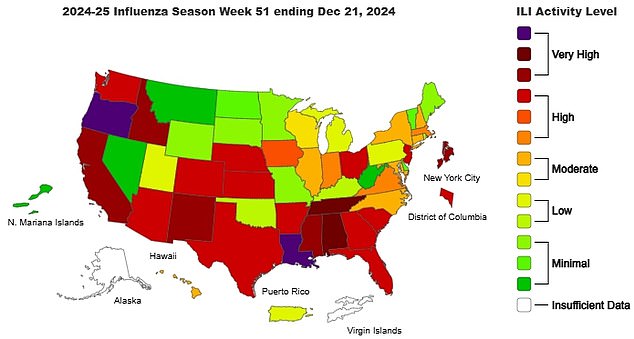Data shows a quadruple virus whammy is hitting the United States as millions of people return to work after the holidays.
Official figures reveal that infections caused by flu, Covid, RSV (a respiratory disease that causes a cold) and norovirus (sometimes called stomach flu) began to increase during the Christmas period, when families gathered to celebrate.
And experts say the numbers will continue to rise in the coming weeks as the United States approaches the peak period of its annual flu season.
Data shows norovirus cases are at their highest level for this time of year since 2012, while RSV hospitalizations increased nearly 40 percent in two weeks.
An estimated 3.1 million people have fallen ill with the flu so far this season, while 37,000 have been hospitalized and 1,500 have died. And the number of states with “very high” levels of the disease has quadrupled in a week, reaching eight.
There are also between 2.5 and 4.4 million Covid cases between October 1 and December 7, estimates suggest, including between 72,000 and 120,000 hospitalizations and between 8,200 and 13,000 deaths.
Rising infections are prompting the return of mask mandates in some states, and this week a Wisconsin hospital system became the latest to reinstate them.
Hospitals in parts of California, Illinois, Indiana and New Jersey have also reinstated rules for staff and visitors. New York City has also urged people to consider wearing masks on public transportation.
The map above shows flu activity levels by state in the week to December 21 of last year. A total of eight states had “very high” levels of the virus
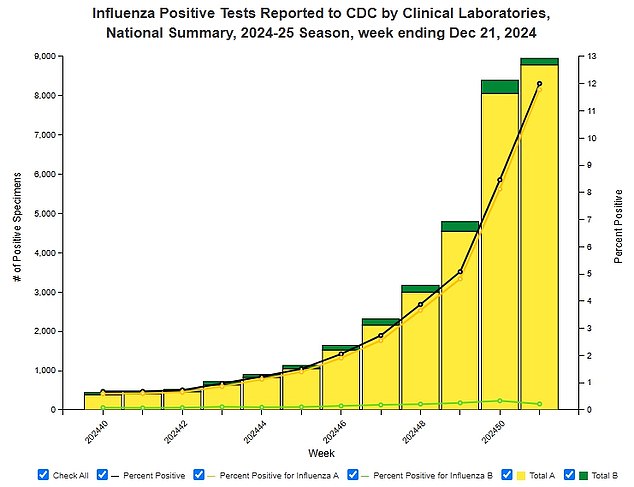
The above shows flu case detections per week in the US, indicating the number continues to rise.
Experts say the rise in winter infections is due to greater mixing during the holiday period and also travel on public transport and airplanes.
The problem is compounded by the fact that people’s immune systems were weakened during Covid lockdowns and work-from-home rules, leaving some at higher risk of more serious illness.
Dr Joe Bresee, an infectious diseases expert who spent two decades at the CDC, told DailyMail.com: ‘What we’re seeing now is an increasing number of respiratory illnesses and noroviruses that are actually all over the United States. .
“That’s what we see most years and we’ll probably see increasing numbers in the coming weeks as well.”
The expert, who also works for the Global Health Task Force, added: “For each of these four viruses, we will see increases through January and then they will peak sometime in January or early February.” But the peaks will be slightly different depending on where you live in the United States.”
Dr. Todd Rice, a professor of medicine in Tennessee, told a local supplier: ‘Being indoors and around many people can lead to greater viral spread.
“(Cases) will probably stay high for another week or two.”
The eight states with very high flu levels are: Louisiana, Washington, Tennessee, Alabama, California, Idaho, New Mexico and Mississippi.
The data also shows that due to RSV, an estimated 22,000 to 45,000 people have been hospitalized with the disease since October, while between 980 and 2,300 have died.
Its hospitalization rate rose nearly 40 percent to 1.8 per 100,000 in the week through Dec. 7, the latest available, compared with 1.3 in the week through Nov. 23.
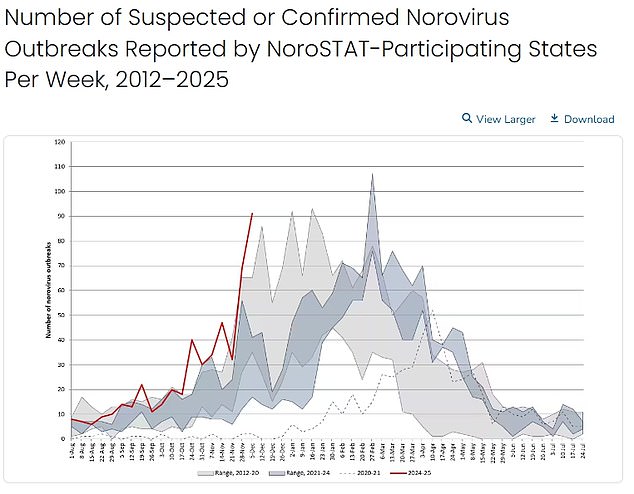
The above shows norovirus detections by week in the US. The number of outbreaks reached its highest level in the first week of December for that week since 2012.
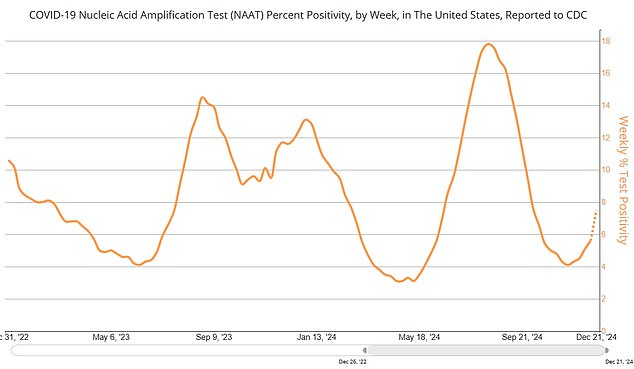
Covid detections are also increasing. The above shows the proportion of Covid tests that are detecting the virus.
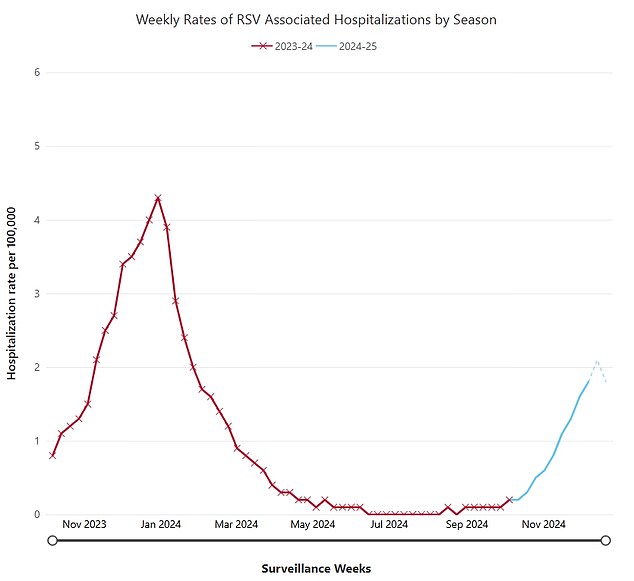
This shows that RSV hospitalizations per 100,000 people have increased almost 40 percent in two weeks.
In the case of norovirus, data show that more than 90 outbreaks were recorded in the first week of December, triple the 30 recorded two weeks earlier.
It was also the largest number of outbreaks recorded at this time of year since 2012.
The unusual rise in norovirus cases may be linked in part to an outbreak in Los Angeles, where at least 80 people fell ill after eating raw oysters contaminated with norovirus at a restaurant.
Dr Bresee previously told DailyMail.com: ‘(Cases) will increase as people get back on planes and travel this holiday season. Any plane today surely has people with viruses on board.
“And we tend to see big spikes right after the winter holidays, when people travel, get infected, and then go back to school.”
Flu, Covid and RSV are primarily transmitted through respiratory droplets that are released into the air when someone coughs, sneezes or even talks.
But norovirus, on the other hand, is transmitted by contact with surfaces that have been touched by someone who is already sick.
Experts say norovirus cases can increase any time of year, but they tend to increase during cold months because people spend more time indoors.
Symptoms of flu, Covid and RSV include fever, cough, shortness of breath and nasal congestion.
Norovirus, on the other hand, is a gastrointestinal illness and causes symptoms including vomiting, diarrhea, nausea, stomach cramps, and body aches.
Each of them can be treated with antiviral medications, as well as pain relievers to relieve the discomfort caused by the symptoms.
Doctors urge those who believe they have a serious infection to visit the emergency room.
Wisconsin’s Aurora Health Care system, which helps 1.2 million patients a year, is among the latest to reinstate mask mandates in its units.
In a notice, it said visitors will now be required to wear a mask “when in contact with patients or in congregate areas, including patient rooms and other areas designated by signage.”
It follows hospital systems in other states such as New Jersey, where its largest hospital system, RWJBarnabas Health, which cares for three million patients a year, has also reinstated its mask mandate.
In guidance posted online, the hospital system also said visitors would now be expected to “wear an appropriate face mask” and “maintain physical distancing.”
He added: “We will offer you a new mask for source control or ask you to replace your own mask with a hospital-supplied mask.”
Rush University Medical Center, Rush Copley Medical Center and Rush Oak Park Hospital in Illinois also began requiring face masks for staff and visitors.
And in Indiana, Union Health has asked visitors to wear face masks due to a rise in respiratory viruses.
To avoid getting sick, the CDC recommends getting an annual flu shot and staying up to date with Covid and RSV vaccines.
The flu and Covid vaccines are recommended for people six months and older, while the RSV vaccine is available for people 75 years and older.
It also recommends other actions to help limit the spread of viruses, including washing your hands frequently, covering coughs and sneezes, and staying home when sick.
The United States is already in the midst of flu season, which lasts from December to February each year.


